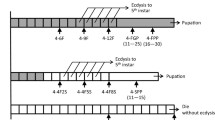Abstract
The spI fraction of high molecular weight secretory proteins was analysed in Chironomus thummi. These proteins are encoded by giant Balbiani ring (BR) genes which develop specifically in salivary gland cells. Each component of the spI fraction was studied electrophoretically from early and middle 4th instar larvae and prepupae, as well from galactose-treated larvae where changes in the relative puffing pattern of BR1 and BR2 are known to occur. The spI fraction consists of at least two bands with electrophoretic mobilities slower than those of the spI components of Camptochironomus. The slow migrating component remains throughout the 4th larval instar, while the amount of the faster component changes, being abundant in early 4th instar and prepupae, but not present (or very weak) in middle 4th instar. The correlated shifts in BR puffing pattern during these developmental stages suggest that the slow and fast components are encoded by BR2 and BR1. The spI fraction is modified by galactose treatment, the fast component being induced in parallel with a decrease in the slow component. These changes are correlated with changes in the steady-state levels of RNA: an increase in BR1 RNA and a decrease in BR2 RNA, and of proteins. These proteins could correspond to the spIb and spIa fractions allocated to BR2 and BR1, respectively, in Camptochironomus. After galactose treatment a new faster band sometimes appears, that could correspond to the spIc fraction of Camptochironomus. A possible spId equivalent was also identified. In conclusion the main features of the spI family in C. thummi are similar to those of spI in Camptochironomus.
Similar content being viewed by others
Abbreviations
- BR :
-
Balbiani ring
- spI :
-
family of Mr=106 secretory polypeptides
References
Bäumlein H, Wobus U, Gerbi SA, Kafatos F (1982a) The basic repeat unit of a Chironomus Balbiani ring gene. Nucleic Acids Res 10:3893–3903
Bäumlein H, Wobus U, Gerbi S, Kafatos FC (1982b) Characterization of a 249 bp tandemly repetitive, satellite like repeat in the translated portion of Balbiani ring C of Chironomus thummi. EMBO J 1:641–647
Bäumlein H, Pustell J, Wobus H, Case SC, Kafatos FC (1986) The 3′ ends of two genes in the Balbiani ring c locus of Chironomus thummi. J Mol Evol 24:72–82
Beermann W (1961) Ein Balbiani-ring als locus einer Speichel drusenmutation. Chromosoma 12:1–15
Beermann W (1973) Directed changes in the pattern of Balbiani ring puffing in Chironomus: effect of a sugar treatment. Chromosoma 42:297–326
Botella L, Grond C, Saiga H, Edström JE (1988) Nuclear localization of a DNA-binding C terminal domain from Balbiani ring coded secretory protein. EMBO J 7:3881–3888
Case ST (1986) Correlated changes in steady-state levels of Balbiani ring mRNAs and secretory polypeptides in salivary glands of Chironomus tentans. Chromosoma 94:483–491
Case ST, Daneholt B (1978) The size of the transcription unit in Balbiani ring 2 of Chironomus tentans as derived from analysis of the primary transcript and 75S RNA. J Mol Biol 124:223–241
Edström JE, Rydlander L, Francke C (1980) Concomitant induction of a Balbiani ring a giant secretory protein in salivary glands. Chromosoma 81:115–124
Edström JE, Sierakowska H, Burvall K (1982) Dependence of Balbiani ring induction in Chironomus salivary glands on inorganic phosphate. Dev Biol 91:131–137
Galler R, Rydlander L, Riedel N, Kluding H, Edström JE (1984) Balbiani ring induction in phosphate metabolism. Proc Natl Acad Sci USA 81:1448–1452
Galler R, Saiga H, Widmer RM, Lezzi M, Edström JE (1985) Two genes in Balbiani ring 2 with metabolically different 75S transcripts. EMBO J 4:2977–2982
Glover M (1985) DNA cloning, a practical approach. IRL Press, Oxford Washington DC
Grond C, Saiga H, Edström JE (1987) The sp-I genes in the Balbiani ring of Chironomus salivary glands. In: Hennig W (ed) Results and problems in cell differentiation, vol 14. Springer-Verlag, Berlin Heidelberg New York, pp 69–80
Grossbach U (1977) The salivary gland of Chironomus (Diptera): a model system for the study of cell differentiation. In: Beermann W (ed) Results and problems in cell differentiation, vol 8. Springer-Verlag, Berlin Heidelberg New York
Hertner T, Meyer B, Eppenberger HM, Mahr R (1980) The secretion proteins in Chironomus tentans salivary glands. Electrophoretic characterization and molecular weight estimation. Roux Arch Dev Biol 189:69–72
Kao WY, Case ST (1985) A novel giant secretion polypeptide in Chironomus salivary glands: Implications for another Balbiani ring gene. Cell J Biol 101:1044–1051
Kao WY, Case ST (1986) Individual variations in the content of giant secretory polypeptides in salivary gland of Chironomus. Chromosoma 94:475–482
Kopantzev EP, Kakarin EI, Kiknadze II (1985) Tissue-specific secretory proteins of the salivary glands of Chironomus thummi and electrophoretic and immunochemical analysis. Chromosoma 92:283–289
Maniatis T, Fritsch EF, Sambrook J (1982) Molecular cloning: A laboratory manual. Cold Spring Harbor Laboratory Press, New York
Nelson LG, Daneholt B (1981) Modulation of 75S RNA synthesis in the Balbiani ring of Chironomus tentans with galactose treatment. Chromosoma 83:645–659
Pelling C (1964) Ribonukleinsäuresynthese der Riesenchromosomen. Autoradiographische Untersuchungen an Chironomus tentans. Chromosoma 15:71–122
Rydlander L, Edström JE (1980) Large-sized nascent protein as dominating component during protein synthesis in Chironomus salivary glands. Chromosoma 81:85–99
Santa-Cruz MC, Villanueva A, Díez JL (1978) Effect of galactose treatment in the puffing pattern of Chironomus thummi Balbiani rings. Chromosoma 69:93–100
Serfling E, Meyer L, Rudolph A, Steiner K (1983) Secretory proteins and Balbiani ring gene activities in salivary glands of Chironomus thummi larvae. Chromosoma 88:16–23
Author information
Authors and Affiliations
Rights and permissions
About this article
Cite this article
Cortés, E., Botella, L.M., Barettino, D. et al. Identification of the spI products of Balbiani ring genes in Chironomus thummi . Chromosoma 98, 428–432 (1989). https://doi.org/10.1007/BF00292788
Received:
Revised:
Issue Date:
DOI: https://doi.org/10.1007/BF00292788




